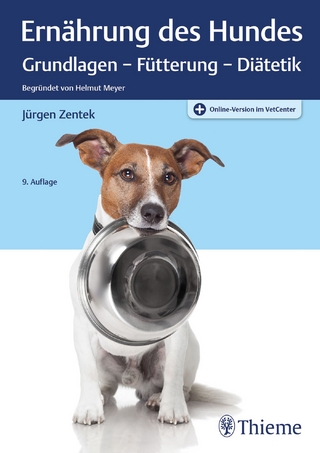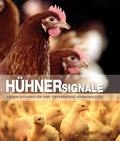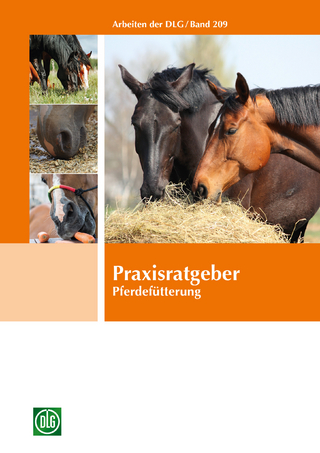
Calving Management and Newborn Calf Care
Springer International Publishing (Verlag)
978-3-030-68167-8 (ISBN)
The reproductive health status in cattle farms is crucial to immediately initiate lactation and new conception. Assistance by technical personnel, dystocia and stillbirth occurrences can reach ca. 50%, 14% and 6% of parturitions, respectively. Hence, zootechnical and veterinary management of calving is of great importance for animal welfare.
This work makes a valuable contribution to teaching and everyday practice in cattle medicine and obstetrics. Veterinary students, residents, practitioners and technical personnel will discover it to be a rich learning and reference resource.
João Simões is a Professor of Large Animal Medicine and Reproduction at the University of Trás-os-Montes e Alto Douro (UTAD). As a clinician and academic, he has dedicated 27 years of his professional career to veterinary students and producers, and collaborated with national and European animal production associations. On the basis of this work experience and research, he has written numerous scientific and technical publications. In recent years, he has also edited several books and special issues on animal production and veterinary medicine for scientific journals.
George Stilwell worked as a practitioner mainly with farm animals for over 15 years before joining the Veterinary Medicine Faculty (FMV) in Lisbon, where he now lectures on Farm Animal Clinics and Deontology and Bioethics. He did his PhD on cattle pain management and is a Diplomate at the European College of Bovine Health Management (ECBHM). He leads the Animal Behaviour and Welfare Research Lab (CIISA-FMV). George has been involved in various European projects on ruminant health and welfare (AWIN, Anicare, BovINE) and in several EFSA working groups. He is a board member of the Portuguese Veterinary Council and has published more than 50 peer-reviewed papers and several books on farm animal health and welfare.
-Preliminary Table of contents-
Chapter
1 Generalities/Introduction
1.1. Reproduction in cattle (definitions, implications with production ...)
1.1.1. Dairy herds
1.1.2. Beef herds
1.2. Reproduction management
1.3. Embryonic, fetal losses and abortion
1.4. Calving
1.4.1. Eutocia (definition)
1.4.2. Dystocia (definitions, incidence, significances, ...)
1.5. The offspring (vitality, mortality,...)
1.6. The challenges and new insights for the care of the dam and calf
Chapter
2 Anatomy of the reproductive systemShort introduction regarding the uterus/ovaries and concept of pelvimetry
2.1. Internal genitalia (Uterus, cervix and vagina/vestibular zone, ovaries)
2.2. External genitalia (vulva, perineum, defects, ...)
2.3. The pelvis Concept of birth canal, applications of pelvimetry
2.3.1. The osseous constituents (sacrum, ischium, ilium, pelvic inlet and outlet...)
2.3.2. Soft tissues (ligaments, articulations, blood vessels, nerfs, pelvic diaphragm, ...)
2.3.3. Conformation and inclination
2.4. Pelvic mensuration (techniques and uses)
2.5. Genetic and nutritional improvement for an adequate pelvis in heifers.
2.6. Most common genetic and congenital defects
Learning objectives/key points and Q&A
Chapter
3 Reproductive physiology Introduction/puberty/others
3.1. Oestrus cycle (characterization; hormones; main reasons for length variation, ...)
3.2. Conception (fertilization, embryonic development, maternal recognition, embryo implantation; hormonal changes, placental development, Is the bovine uterus a sterile environment?, ...)
3.3 Pregnancy length (related factors; claws, infections and discomfort, myometrium contractility during late pregnancy, ... )
3.4. Effect of pregnancy stage on milk composition
3.5. Anoestrus - causes and consequences
3.6. Factors affecting reproductive physiology and fertility (virus, genetic, malnutrition).
Chapter
4 Non-pregnant and pregnant cow's management
4.1. Management of timed fertilization/insemination (Genomic evaluation of age at first calving, determination of optimal time in heifers and in adult cows, ...)
4.2. Twins (incidence, implications, potential reduction, ...)
4.3. Management of the pregnant cow (diagnosis, rectal palpation and pregnancy loss, nutritional management during lactating period, vaccinations, serum metabolites during pregnancy...)
4.4. Management of the pregnant heifer
4.5. Transition period
4.5.1. Implications of dry period length
4.5.2. Changes in the mammary gland
4.5.3. Nutritional management (negative energy balance, minerals, BCS, feed intake,...)
4.6. Colostrum (characterization, nutritional value, immunoglobulin G1, G
2 and
M concentrations, preservation...)
Learning objectives/key points and Q&A
Chapter
5 Normal birth (eutocia)
5.1. Parturition induction and hormonal changes (physiologic induction, artificial induction)
5.2. Fetal static (classification, assessment,...)
5.3. Prodromal external signs of parturition
5.4 Stages of labor
5.4.1. Stage
I or dilatation stage (signs, duration, changes...)
5.4.2. Stage
II or fetal expulsion stage (signs, duration, changes...)
5.4.2.1. Prediction and management (Body/rectal/vaginal/eart temperature; Rumination and feeding behavior; Combined pelvic ligament relaxation and teat filling measurement; Behavioral changes; Steroid assays, use of automated monitoring devices and electronic data loggers to predict the calving)
5.4.3. Stage
III or placental expulsion (signs, duration, changes...)
5.5. Fetal physiology during parturition
5.5.1. Respiratory changes
5.5.2. Cardiovascular changes
Learning objectives/key points and Q&A
Chapter
6 Abnormal occurrences during calving
6.1. Causes of dystocia (Fetal and/or maternal; new tentatives of classification,...)
6.2. Fetopelvic disproportion and absolute fetal improved size
6.3. Fault dispositions (abnormal fetal static)
6.4. Inadequate size of birth canal
6.5. Inadequate forces
6.6. Fetal congenital defects affecting calving
6.6. Signs of fetal stress (how to identify, how to avoid, how to correct)
6.7. Human intervention in dystocia (lubrification, epidural, sedation, episiotomy, pulling...)
Learning objectives/key points and Q&A
Chapter
7 Assisted vaginal delivery
7.1. Obstetrical examination
7.2. Appropriate time for obstetrical intervention
7.3. Scales to measure the need for assistance
7.4. Appropriate installations for calving (maternity features...)
7.7. Post-calving assistance
Learning objectives/key points and Q&A
Chapter
8 Obstetric manoeuvres
8.1. Definitions and classification of obstetric manoeuvresAll procedures with scientific illustrationLearning objectives/key points and Q&A
Chapter
9 Fetotomy
9.1 Indications and contraindications
9.2 Dam preparation
9.3 Material for different types of fetotomy (percutaneous
9.4 Procedures (parcial and total fetotomy)
9.5 Post-intervention careLearning objectives/key points and Q&A
Chapter
10 Caesarean Section
10.1. Indications and contraindications (including the surgical approach)
10.2. When to go for a C-section
10.3. Dam restraint methods
10.4. Anesthetic protocols
10.5. Different surgical procedures
10.6. Postoperative care
Learning objectives/key points and Q&A
Chapter
11 Obstetric problems before or during calving
11.1. Uterine torsion
11.1.1. Ethiopathophysiology
11.1.2. Diagnosis
11.1.3. Treatment
11.1.4 Post-intervention care
11.2. Vaginal prolapse
11.2.1. Ethiopathophysiology
11.2.2. Diagnosis
11.2.3. Treatment
11.2.4 Post-intervention care
11.3. Hydrops (Hydrallantois/Hydramnios)
11.3.1. Ethiopathophysiology
11.3.2. Diagnosis
11.3.3. Treatment
11.3.4 Post-intervention care
11.4. Lacerations, hemorrhages and organ rupture
11.4.1. Ethiopathophysiology
11.4.2. Diagnosis
11.4.3. Treatment
11.4.4 Post-intervention care
Learning objectives/key points and Q&A
Chapter
12 Post-partum management
12.1. Pain management after calving
12.2. Uterine involution (including factor which affect cervix closure, ...)
12.2. Resumption of estrous cyclicity (Dairy and beef cows,...)
12.3. Influence of calving events and post-partum health on fertility.
Learning objectives/key points and Q&A
Chapter
13 Post-partum diseases
13.1. Uterine prolapse
13.2. Hypocalcaemia (milk fever)
13.3. Downer cow
13.2. Retained placenta
13.3. Puerperal metritis
13.4. Endometritis and pyometra
13.5. Other diseases and their relation with calving - ketosis, fatty-liver, mastitis
Chapter
14 Care and management of the newly born calf
14.1. Newborn calf vitality: Risk factors, characteristics and assessment
15.1.1. Fetal resuscitation
15.1.2. Clinical examination of the newborn (reflexes, pain,)
15.1.3. Hypoxia and acidosis
15.1.4. Trauma and pain
15.1.5. Genetic and congenital defects
15.1.6. Euthanasia
14.2. Colostrum management
15.2.1. Quality assessment
15.2.2. Time, quantity and ways to provide colostrum
15.2.3. Evaluation of failure of passive transmission
14.3. Environmental comfort and hygiene
14.4. Neonatal diseases (onfalitis, hernia, diarrhea...)
14.5. Calf growth (milk replacers, development of rumen, ...)
14.6. Weaning
Learning objectives/key points and Q&A
| Erscheinungsdatum | 31.08.2021 |
|---|---|
| Zusatzinfo | 204 illus., 138 illus. in color. |
| Verlagsort | Cham |
| Sprache | englisch |
| Maße | 178 x 254 mm |
| Gewicht | 719 g |
| Einbandart | gebunden |
| Themenwelt | Veterinärmedizin ► Allgemein ► Tierernährung / Tierhaltung / Tierzucht |
| Veterinärmedizin ► Großtier ► Rind | |
| Weitere Fachgebiete ► Land- / Forstwirtschaft / Fischerei | |
| Schlagworte | Beef cattle • calf • calving • cattle • Colostrum • Congenital defect • Dairy • DAM • dystocia • Eutocia • Herd Health • Nutritional Management • Obstetric problem • Obstetrics • Parturition • Pelvimetry • Peri-partum • post-partum • Reproduction • welfare |
| ISBN-10 | 3-030-68167-X / 303068167X |
| ISBN-13 | 978-3-030-68167-8 / 9783030681678 |
| Zustand | Neuware |
| Haben Sie eine Frage zum Produkt? |
aus dem Bereich


